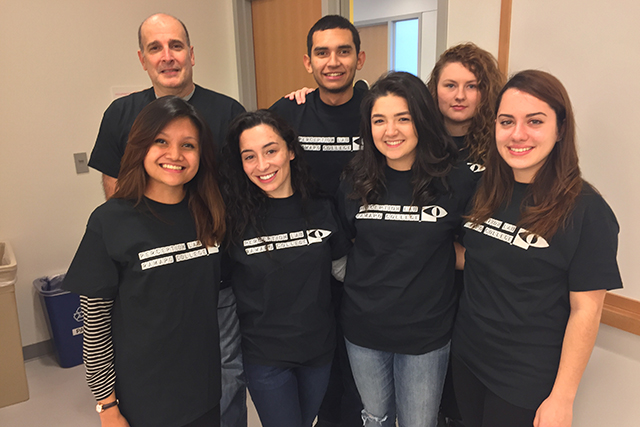
Photo courtsy of Monica Lucianna
Since October, seven Ramapo students have been working alongside Dr. Joseph Cataliotti, associate professor of neuropsychology, in a psychology research group. One of many psychology research groups on campus, Cataliotti and his students are working on two lines of perception research, the interaction between proprioception and mirror tracing, as well as color perception.
“The goal is to discover the basic processes by which human vision and perception take place…It’s a puzzle and so it’s just a challenge to figure out how humans experience the world – what are the processes? That’s the fun part. When we talk about basic versus applied research I ask my students this – what would you hope to accomplish by landing on the moon?…Primarily there is the thrill of pure discovery. When students get involved in basic research, just like with the moon landing, there are also secondary benefits that are come about as part of the process. When students get involved with basic research, they’re learning all sorts of things that are incidental. There’s secondary learning that takes place,” Cataliotti said, explaining that the goals of his group are far larger than simply conducting basic research and often involve providing students with experience valuable to their careers.
According to College Board, 16 percent of Ramapo’s students are psychology majors, making psychology one of Ramapo’s most popular subjects. With that level of interest, there are currently 10 other psychology groups conducting similar faculty-led research. Each of these groups is usually comprised of two to eight students, with involvement ranging from just a semester to two years of research. According to Cataliotti, over the last 15 years, research groups on campus similar to his perception group have increased. He himself has been doing this sort of work with student assistants since 1992, working with somewhere near 100 students in that time, many of his groups present at local or regional conferences, and many of his students have gone on to graduate school.
“We have a lot of psych majors and for them to be able to sit down with a faculty member in a group like this and have these sort of interactions — is really important. They’re not going to get these casual and extended experiences in a normal classroom. The research lab experience is a special kind of classroom. There is sustained focused learning, and as part of the research lab interactions, professors really get to know their students, and the students really get to know a single professor. It also helps them professionally. The lab experience helps build their thinking and their professional development. As a consequence of this and given that I have learned a lot about my students, I am better able to write a letter of recommendation for graduate school or a job — it’s really important,” Cataliotti said.
Cataliotti’s group in particular is looking at two lines of research, the first involving proprioception and mirror tracing. The group recently asked volunteers to participate in a series of tasks, one of which involved tracing the outline of a star but not looking at their hand. Instead, participants were asked to look at the reflection of their hand tracing the star in the reflection of a mirror.
“What we’re trying to figure out is how to affect the mirror tracing task — how to facilitate and increase performance, or to inhibit it in some way." Cataliotti said.
The group’s second line of research involves color perception. Looking at the simultaneous lightness contrast illusion, the group hopes to find out more about "super seers," or participants who cannot see the illusion, which is widely accepted to be experienced by all.
“We’re trying to figure out what makes a super seer a super seer. Why are they super seers? Why are they not seeing the illusion while most people — say, 95 percent of the population — does see the illusion?” Cataliotti said.
For the students involved, many of which have taken Cataliotti’s classes before, the research group allows them to apply what they have learned in the classroom to a real lab setting.
“I’ve gained more knowledge about perception from doing hands on experiments, which is something you don’t always get to do in a class,” Emily Shipley, senior, said.
Monica Lucianna, a junior in the research group, commented further on the professional benefits of the group.
“By discussing ideas with a group, I've learned to work together with others in a professional way and have ideas grow from that,” Lucianna said.
The idea of gaining professional experience seems to be one of Cataliotti’s main goals with the group.
“They have this sort of a professional socialization that takes place that you would not get in a classroom. The conference presentation and the conference attendance are part of that — so they get to see what it’s like to be a graduate student. The students that I work with actually get to go to a conference and interact with other students who are graduate students. The research assistants also have to design and create a poster presentation and present it to the rest of the campus,” Cataliotti said.
The group is planning to present their findings at Ramapo’s Psychology Research Symposium later this spring.
ssprovie@ramapo.edu






